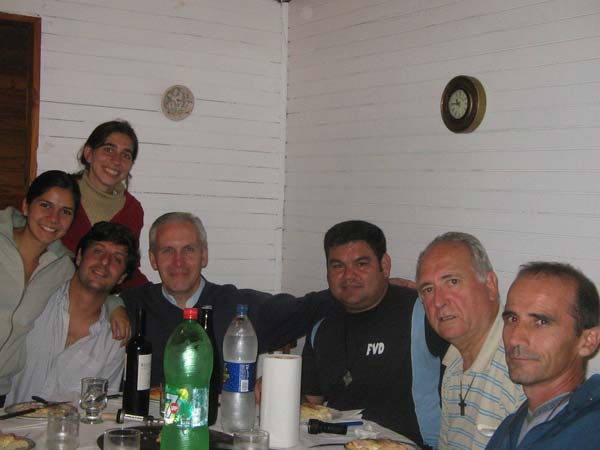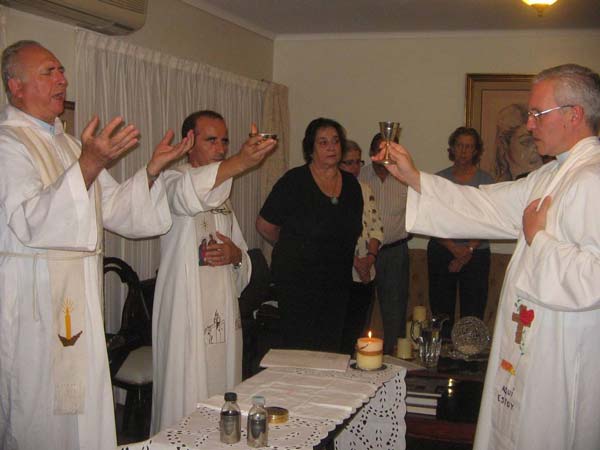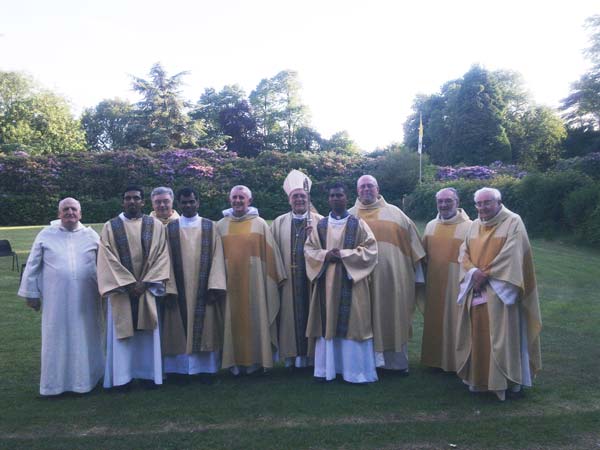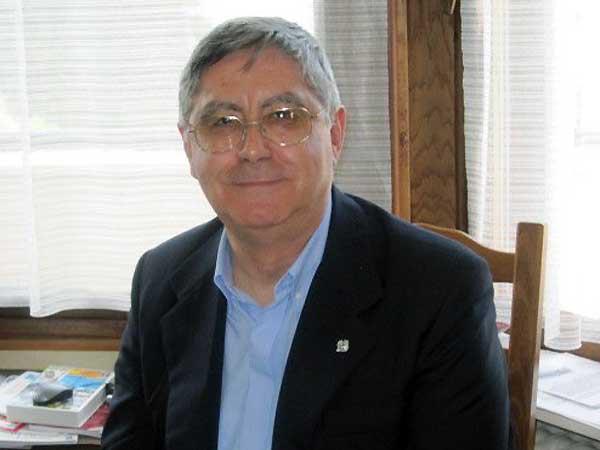Family news - 2012 May 14th
Contents
- A word from the Superior general
- Saint Michael Garicoïts wrote...
- Logo for the 150th anniversary of the death of St Michael.
- We are a Christian missionary family, of Betharramite spirituality on the increase.
- 5 minutes with the Community of Olton
- A History of the General Chapters of the Congregation of the Sacred Heart of Jesus of Betharram (5)
| formato PDF |
La parola del Padre Generale
TOWARDS THE 150th ANNIVERSARY OF THE DEATH OF ST MICHAEL GARICOITS.
Rome, 14th May 2012.
Dear Fathers and Brothers,
In a years time, on 14th May 2013, we shall be celebrating the 150 years since the death of St Michael Garicoits. At the request of the 26th General Chapter and in agreement with the Council of Congregation we have decided to celebrate during a whole year such an important moment in the life of our Father, St Michael Garicoits. It will be a Jubilee year ending 14th May 2014!
When he died St Michael was enduring a combat of the heart. And what a combat! The lack of understanding on the part of the Bishop of Bayonne, Mgr Lacroix, about that gift of the Holy Spirit to St Michael resulting in the difference of appreciation on the very nature of the society of priests of the Sacred Heart of Jesus. Knowing his diocese as he did, the Bishop considered the wish to assemble St Michaels companions to be a good response to the pastoral needs of his diocese. He wanted them to set themselves up as a society of apostolic life. Besides, the Bishop had no authority to set up a congregation; this belonged to the Pope alone. So why complicate things with a holy illusion? St Michael was a mystic. After long and serious discernment, he came to realise that the Holy Spirit had given him the gift of a new charism, which according to Fr Etchecopar was far from being an illusion. This new charism consisted in showing and reproducing the humility and obedience of Jesus; which meant that for those who wanted to give their lives to the Lord, they must make vows, live in community under the authority of a superior and dedicate themselves to obtaining the same happiness for others.
Such a conflicting project resulted that in the same community were individuals living under the two regimes: some had made vows, others not; some retained the management of their possessions, others not. Such a diversity of situations resulted in great confusion and caused the departure of some. With the result that for St Michael, what the Lord had revealed and desired could not be realised. Worse still, what had been started with great enthusiasm to answer the call of the Lord and to be faithful to Him was falling to pieces, crumbling and falling apart. Despite such a terrible failure, St Michael didnt confront the Bishop, proving himself to be obedient in everything concerning the Congregation. St Michael died a good diocesan priest, at the same time seeing that the society which he had founded would soon no longer exist. This situation was hiding a mystery: configuration with Christ obedient unto death and death on the Cross. From his Cross Jesus may have felt that his mission also was a failure, but he continued to be certain that his Father was faithful to his promises and he, Jesus, always did what his Father willed. Just like Christ, our Father St Michael continued to be obedient to death and death on the Cross; he died on the cross of obedience. The same thing happens to the Lords friends. The Lord asked Abraham to sacrifice the son which He had given him, the son of the promise. Moses died only seeing the Promised Land from Mount Nebo, even though God had asked him to lead the chosen People there. Likewise with Elija.
The Lord gave the gift and joy of the Betharramite charism to St Michael: to know, love, imitate, manifest and announce Jesus, humble and obedient, and to share this same happiness with everyone. To be a worthy witness of this St Michael had to be tried to the limit. He had to show that what he said about Jesus, humble and obedient wasnt just simply words but a life style; he had to be ready to give up all his projects, to see them come to nothing despite the pain that caused him until Gods project for salvation was realised in himself and in others. Was there anything dearer to St Michael than the Congregation? He had to prove that it wasnt his Congregation but firstly that of the Sacred Heart of Jesus, the one and only who could keep it alive. And to achieve this he had to show that he was ready to see the Congregation reduced to nothing, just as Abraham was ready to sacrifice Isaac, his son, the son of the promise.
He had the intuition and the stuff of which saints are made. The experience of the God of Love who had given a fresh orientation to his life when he was in his thirties helped him to enter into the mystery of God and to be convinced that the Heart of Jesus, which had shaped the Congregation, was the only one worth while and that without Him the Congregation was nothing. It wasnt the Congregation of Fr Garicoits but the Congregation of the Sacred Heart of Jesus. Just like Abraham, just like Jesus who learned to prefer the Father of the Mission rather than the Mission of the Father, whose messenger he was, a missionary. Just like Jesus saying Not my will but thine be done, Father (Mk 14,36), St Michael Garicoits, not trusting his own will or that of the Bishop, not acting on his own bat but always with Gods Spirit, always faithful to Gods commandments, to suffer and do whatever was wanted of him (Manifesto).
St Michael Garicoits took risks, because faith always demands risks! Its good to take risks, to leap in the dark, knowing that I will be caught in loving hands and not get lost or crash to the ground. For he who keeps his life will lose it, but he who loses his life for my name will save it (Mt 16,25) St Michael Garicoits ran the risk that his plan for the Congregation, inspired by the Holy Spirit, should end in failure. He didnt think that he was indispensable, trusting only in the God who had inspired the project, the Sacred Heart of Jesus, had the power to save the Congregation if it was what he really wanted. And today we are witnesses to this miracle
I think that we ought to take advantage of the celebration of these 150 years since the death of our dear Father and Founder to seize what he himself and our rule of life are reminding us: what should be our principal characteristic is our spirit of obedience; if obedience is lacking the raison detre is lacking (RoL 60). Obedience to death, even to death of the cross for Jesus as for St Michael; the obedience of the disciples trusting more in the God of Love revealed to us by Jesus and then St Michael, rather than in our own little projects which are often obstacles in our response with a little love for Him who loved us first. This is something which will make us more genuine in our vocation and more credible in our mission, for then we shall be the joyful witnesses to the God of Love who loves us in the Heart of his beloved Son, Jesus.
The theme chosen for the celebration is: From the heart of Christ to the heart of the world. Fr Enrico, Vicar General, is appointed to coordinate the three Regional Superiors for the preparation of the festivities. The plan is that each Region will set up a commission to animate the jubilee for the communities in each vicariate. Lets go and drink at the source of our dear Founder; lets ask the Sacred Heart who conceived and shaped our religious family, the grace of spiritual renewal for each religious and Betharramite community; lets ask for the grace of new vocations who will continue to live with us the priceless gift and source of joy of the charism which has been transmitted to us through St Michael Garicoits .
On this feast of St Michael Garicoits I send my best wishes to all the Betharramites religious, laity, young and old, men and women.
Gaspar Fernández, SCJ
 Saint Michael Garicoïts wrote...
Saint Michael Garicoïts wrote...
Here are two conditions fundamental for the virtue of obedience.
Firstly we must love God who gives the command and secondly we must love what is commanded. Generally speaking all failings in obedience are the consequences of a lacking in these two conditions. There are those who love God who gives the command but not what has been commanded. On the other hand there are those who love what has been commanded but not God who is giving the command. A Superior will order me one thing. Ill carry it out not only with patience; another will tell me to do the same thing, I will not do it or I will do it with such bad grace that it will scandalise my brothers; is it not the same will of God which is announced? If I love the divine will and if I love God who makes it known to me, why can I not accept it from this superior or that one? There are those who love what is commanded but do not love God who is commanding it. And so, I will be given an order. What assiduity! What devotion! The fact is, I love the thing commanded. It all comes from pride! Heres the proof: if you were to remove me from there and put me to work at something else that I dont like , either I will refuse, or I will carry out the order so badly; but is it not now obvious that its not God I love but the thing commanded? (M 370).
PREPARING THE 150TH ANNIVERSARY

LOGO FOR THE 150th ANNIVERSARY OF THE DEATH OF ST MICHAEL.
In 2013, our religious family of the Sacred Heart of Jesus of Betharram will be celebrating the 150th anniversary of the death of our Founder, St Michael Garicoits.
The last Council of the Congregation (January 2012) drew up a plan of dedicating a whole year to remembering the Saint of Betharram. With this edition of the NEF begins a special rubric allowing us to set out on this voyage of discovery.
Here is the chosen theme: From the heart of Christ to the heart of the world. This theme wants to underscore the link uniting the heart of Christ to the whole of humanity. We want to remember how St Michael was a man docile to the Word, who embodied the double attention: fidelity to God and fidelity to mankind. The love which was his food for God directed him towards mankind of his time.
In his writings we come across, in an evident fashion, this double attention which is nothing more than the two sided vision of the same reality.
Following his example, the religious of the Sacred Heart are faithful to this double attention which is best expressed in the axiom: It has pleased God to be loved. At the sight of such a wonderful spectacle the priests of Betharram felt called to do all they could to imitate Jesus, humble and obedient, so as to obtain the same happiness for others.
To whom is this proposition to compose a logo addressed? To all young candidates aged 17 to 30 years of age. Anyone who wants will find the announcing of the competition on our website www.betharram.net where all the conditions for participation are stated fully. Remember that with this first act we want to engage all the youth and give them a chance of saying what is dearest to them and what the figure of St Michael means to them. Our communities are entrusted with the task of encouraging the young and getting them involved. This notice of the competition is to be spread as widely as possible so as to give rise to questions and be an occasion for reflection.
Closing date of the competition. The competition will end 14th November 2012. By this date all the work which will have reached Fr Enrico Frigerio (Vicar General) at the Generalate, will be studied by a special commission who will choose the logo. This logo will be the official symbol in the whole Congregation for the year consecrated to celebration the 150th anniversary of the death of St Michael.
What is the prize? We have thought that for the young competitor who wins the competition there could be no better prize that participation at the World Youth Days which will be taking place in Rio de Janeiro (Brazil) 23rd 28th July 2013.
In this year of grace we want to set out on this journey; we are being invited to deepen our knowledge of the personality of our Father St Michael and absorb his human and spiritual qualities on the route from the heart of Christ to the heart of the world.
Lay Spirituality

WE ARE A CHRISTIAN MISSIONARY FAMILY, OF BETHARRAMITE SPIRITUALITY ON THE INCREASE.
Come è iniziato tutto? Come siamo arrivati qui? Le vie di Dio sono imperscrutabili e imprevedibili, ma misteriosamente, chissà da quando, Egli stava preparando i nostri cuori... a poco a poco parlava dentro di noi, nelle vicende della vita quotidiana, nella coppia...
Così inizia il cammino di Tomás e Natalia: un itinerario che li ha portati a vivere lesperienza come missionari betharramiti laici in una zona rurale del nord dellArgentina.
Unesperienza forte e intensa che abbiamo raccolto in poche pagine, ma che, per il lettore curioso, può essere arricchita dalla lettura dellesperienza sul loro blog: ttp://misionbetharramitasiambon.blogspot.com.ar/
Reflecting with St Michael Garicoits.
In the text of the Manifesto, St Michael tells us how he was captivated by the mystery of God made man for love of us, and how he was dumbfounded in the presence of this magnificent action. He wanted to pass on this experience so that we too should be likewise in the presence of Gods love and have Jesus as an attraction, a model and a means.
God was pleased to be loved and while we were his enemies, he so loved us that he sent us his only begotten Son. Jesus comes out to meet us and he calls us to the same love as we see mentioned scores of times in the Gospels. This isnt just empty words or simply a commentary and nothing more; it is quite simply all about Jesus who, like us, is real and tangible. Love takes possession of us not by force, for violence banishes peace, but just like lovers, making their relation eternal (as we read in the Song of Songs). Jesus captivates us as if life were a game, including moments when all seems lost like that night in the olive groves during his prayer when those whom he loved dearly became hi enemies. But the love of the Trinity is strong, infinite and generous. By rising from the dead Jesus leads us with Him into life.
In our lives all this becomes very concrete and actual in so far as we let our hearts of stone be melted by the fire of the Heart of Jesus so as to be able to say with Him: Father, here I am to do your will. This is how we procure the same happiness for all those whom God lets us meet. The text of the Manifesto possesses a Trinitarian dynamism which opens with the Fathers love, through the Sons mission, animated by the Holy Spirit. We are invited to enter it by whatever means possible; our lives will find there their unique raison detre and their motivation.
The Son of God became man What better modal can we find for the life and spirituality of the laity than in the mystery of the Incarnation at the heart of our work, the family and social justice? Jesus Christ, God made man, really shouldered our human condition from the moment of his conception and during his entire life, by submitting himself to tough working conditions (in the hidden life in Nazareth), to bureaucratic politics (the census in Bethlehem), to injustice (judged and condemned unjustly before Pilate) to death on the Cross. I wonder how many of us, laity, see the Kingdom at the heart of such realities. In the state of life in Latin America where work and the economy are a major preoccupation for most families, where the rule of bureaucracy crushes the poor and does them great harm, where social injustice is blindingly obvious because so many of our brothers and sisters are excluded from health care and good education. Where do we find the light and the strength to announce, as disciples, that the Kingdom of God and hope of the Resurrection have arrived. St Michael assures us that the Son of God made man is our attraction, our modal and our means. By being united to Him, like the vine shoots, we can transform the structures which lie at the heart of the limits of our position whether its the childrens education, fraternal life within our communities, work, or church situations, as in the use and sharing of goods and money.
Making the Betharramite family grow in Sambian.
As a Betharramite community here in Sambiam, we want to be ever more united to the Heart of Jesus as well as to all Betharramites world-wide, sharing the same charism, each according to his vocation and particular mission. Little by little our little community is on the increase, first of all with the forthcoming arrival of our first child, then that of another missionary, Amelia Juiz who joined us in the month of March. She is trying out life with us for a year. Added to all this there is the joy of seeing the countless fruits of the mission during the past year. Theres something to fill the heart with joy! We ought to thank the Lord for all the help and accompaniment received from the Fathers and Brothers of Betharram who have accompanied us from the start especially the roving community from Santiago del Estero.
We are sure that the Lord will send more missionaries to share this life with us! May the peace of the risen Christ fill our hearts with a lively faith, a hope which does not deceive and a love burning for God and for all mankind!

5 minutes with...
... The Community of Olton

Nel nostro itinerario nelle comunità della Congregazione, ci siamo fermati qualche istante nella comunità di Olton (Vicariato dInghilterra) e abbiamo rivolto loro alcune domande... Ne esce il ritratto di una comunità concentrata sullessenziale della vita religiosa e protesa con fiducia verso il futuro che, seppur nelle mani di Dio, è tuttavia affidato alla responsabilità e alla creatività degli uomini. La presenza dei religiosi non solo nella Parrocchia, ma anche nei collegi come animatori spirituali, è diventata un ambito importante per una testimonianza gioiosa e pro-vocante...
Nef: Could you please outline the history of the presence of the Religious of Bétharram in the Parish of Olton?
-Back in September 1980 the Capuchins decided to leave Olton after a 90 year presence, since it was no longer their house of formation. They decided to give The Friary to the Archdiocese of Birmingham, and so Archbishop Dwyer invited us to move to Olton from Garicoits House Worcester (our old Formation House). We came here in January 1981, and at first were nervous as to how people would accept us after nearly a century as a Franciscan parish. But within a few months people had taken us to their hearts. Brother John and Brother Liam in particular were instrumental in breaking down barriers and winning hearts and minds. Fr Ted was appointed as Parish Priest and is still carrying out this important ministry, thank you Fr Ted!
Do you believe that the people around you consider your ministry, carried out in your community, as something different from the ministry fulfilled by the parish ministers in the diocese? If yes, in what way?
- Most definitely! People in the parishes around us seem to appreciate the presence of a religious community. So too do the diocesan priests. We work in close collaboration with the diocese in both parish and school ministry, and people in general appreciate our accessibility and simple way of living. The differences that people appreciate are less in particular things that we do, but rather more in the simple fact of living together as a praying community with all our differences and oddities and foibles. When families outside are struggling with their own issues and see us trying to be faithful in spite of all our difficulties, then they are given hope. A simple community activity like caring for the sick and elderly is a sign of hope for families who struggle to look after their own sick and elderly.
People see our daily witness, the gift of saying each day in faith: Here I am Lord, I come to do your will.
In your vicariate, there are as many religious brothers as religious priests. How this situation can be a worth for Betharram in England?
-Firstly this was an act of God: In the 1980s we had a sudden increase of vocations, but all those who joined as priests left the Congregation while all those who joined as Brothers, stayed. Secondly the presence of Brothers has helped the communities retain a sense of balance and purpose. That is, religious community life is prioritized and celebrated. If we had still retained the same proportion of priests as of old, the temptation would have been irresistible to bow to Diocesan pressures and disperse into parishes in ones and twos, so losing our identity altogether. The Brothers have in effect guaranteed that we focus on our Charism.
For some years now a few religious from the Vicariates of India and Thailand have been coming to England for studies or minister activities. What are the difficulties and the positive aspects?
- The students we have welcomed from Thailand and India have been a breath of fresh air to our communities especially the formation house of Olton. They have brought youthful energies with them, and the Indian brothers especially helped to reconnect us with the younger generations in the parish. They were in effect a kind of reminder of what it is to be a functioning training house of formation, with all the joys and pains therein. The financial costs were a bit of a shock to the system (the total cost for 3 brothers over 4 years was £ 100,000) but the gifts they brought to the vicariate and to the wider Congregation more than outweighed the costs. Out hope had been that they would improve communication between the different parts of the Region, and they have done that and much more besides. We would hope to repeat the process at some time in the future, but will have to wait till vicariate finances recover a little.
How important is vocation promotion in your community project?
-Vocation promotion has been carried on in an unspectacular way by many of us, especially Brother Andrew Brother Michael, Fr Dominic and Brother Gerard despite a very harsh climate for religious vocations in England for 25 years. Nationally there is an emerging upturn in vocations, which we hope to take advantage of through our new Betharram Spirituality Group, formed for retreat & animation for lay groups of all ages. We are also blessed with a presence in local Catholic Schools where we minister as Chaplains and School Governors.
5. THE GENERAL CHAPTERS BETWEEN THE TWO WORLD WARS.
The expulsion of the French Betharramites was a turning point in the history of the Congregation. It was the end of a period when the works of Fr Etchecopar were still marked by St Michael.It was the end of an era; in so far as the expulsion forced the Congregation to take a serious look at her place in the Church and in the world. The Works founded by St Michael and linked to his memory and his action no longer existed; expelled from France in 1903, the Betharramites will not return before 1920.
By then new types of activity were surfacing in the service of Evangelisation, for example the charge of parishes. Already before then and as a personal gesture, some parishes had been entrusted to a few of the Fathers, for example the parish of Lestelle near Betharram. From then onwards the Superiors accepted opening communities to be responsible for parish ministry. This represented something new and for some it was a shattering experience. To the extent that when Fr John Magendie was informed that he had been chosen to be first Parish priest for Barracas, in the suburbs of Buenos Aires, he told the General Superior I didnt enter Religious Life to be a Parish Priest!
It is the start of a new era, and the Congregation was being asked to broaden its horizons. New countries were being added to France, Palestine, Argentina, and Uruguay. In England, the early stages like a mission field were definitely over with the foundation in 1909 of the parish of Droitwich, followed later on by the college.
In Belgium it is the foundation of the Apostolic School which was the scene of some upheavals during the German occupation between 1915 and 1918; it was closed down in 1920. In Spain three residences were opened: one for the elderly Religious (Buena Vista), the Generalate (maison Cesarios), and the Apostolic School. In Italy the Congregation opened two houses: the Apostolic School at Traona (Valtelina) and the Procure in Rome. In 1904 it was the opening of St Josephs College in Asuncion (Paraguay).
On 11th March 1922 began the mission to China, at Yunnan. In 1937 it was the foundation of the St Michael Gymnasio at Passa Quatro in Brazil. Finally, just before the end of World War II Betharram accepted to open the Charles de Foucauld College in Casablanca (Morocco). The expulsion of the Religious from France represents a period of great vitality and expansion: from 1900 to 1940 more than 30 communities were opened. The opening of local Seminaries resulted in the entrance not only of French religious but also Italians, Spanish, English, Belgians, Argentines, Paraguayans, Brazilians, and Uruguayans. Father Estrate, the Superior General, said We would never have thought of going to England, nor to Spain, were it not for the expulsion.....Really it has been a blessing from God!
The General Chapters of that period : 1909, 1911, 1919, 1923, 1929, 1935 assured the management and organisation of this new reality, reconciling the old with the new, the customs of days gone by with something new, the past laden with history with the hopes for the present and the future. When you come to reading the Acts of these Chapters you realise the major preoccupation of the Chapter Delegates: what spirit was to be given to the Congregation? The scattering of the Religious worldwide, the acceptance of young candidates not only foreigners, but of different cultures, made it absolutely necessary to confirm what was essential in the Spirituality handed down by Fr Garicoits and Fr Etchecopar and obliged the Superiors of that time to prepare better projects for the formation of young candidates, the hope of the future of the Institute. The worry not to scatter the heritage resulted in the choice of opening only one novitiate and only one Seminary for the entire Congregation.
Roberto Cornara
Document Actions










